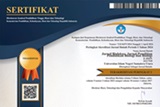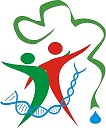STEM-PjBL: Its effect on students creative thinking skill in environmental pollution material
Abstract
Teaching and learning in the 21st century should equip students with creative thinking skills to be ready to live and contribute productively to society. This study aims to determine the effect of the implementation of STEM-PjBL on Creative Thinking Skill in Environmental Pollution Material of 7-grade. The quasi-experimental design of the nonequivalent pretest-posttest control group was used in this study. The subjects in this study were students of class VII at SMP Negeri 37 Medan. Subject selection was done by purposive sampling technique. The samples of this study consist of class VII-D as the control class and class VII-C as the experimental class. Data collection techniques used in this study were test techniques. The instrument used was the multiple-choice questions consist of 25 questions to measure student learning creative thinking skill based on the Tawil and Liliasari from Building The Knowledge, Arouses Curiosity, Looking at The Different Angle of Information and Forecasting Limited Information. This means that there is an effect for learning between the experimental class and the control class. The average result of the student creative thinking skill in the experimental class was 91% (very good category). The results showed that there was a significant effect of the STEM-PjBL Model on Students Creative Thinking Skill learning was in 0.030 for effect learning with t-test and this is the results of the t-test obtained that the 2-tailed significance value, the STEM-PjBL model can be used as an alternative learning to empower 21st century skills.
Keywords
Full Text:
PDFReferences
Afriana, J., Permanasari, A. & Fitriani, A. (2016). Project based learning integrated to STEM to enhance elementary school’s students scientific literacy’. Jurnal Pendidikan IPA Indonesia, 5(2), 261–267. https://doi.org/10.15294/jpii.v5i2.5493.
Aisyah, N. & Rosnita, R. (2021). Pengaruh Project Based Learning pada Materi Sistem Koordinasi terhadap Hasil Belajar Kognitif Siswa. Jurnal Biolokus, 4(1), 14-19. https://doi.org/10.30821/biolokus.v4i1.816.
Akhiril, P. (2014). Peningkatan Kemampuan Berpikir Kreatif Siswa dengan Menerapkan Model Pembelajaran Quantum Learning Materi Sains. Logaritma, 2(1), 1–13.
Alkautsar, S., Nuryady, M.M., Husamah, Wahyono, P., & Miharja, F.J. (2023). STEM-PjBL Worksheet : Ways to Improve Students’ Collaboration, Creativity, and Computational Thinking. Jurnal Kependidikan: Jurnal Hasil Penelitian dan Kajian Kepustakaan di Bidang Pendidikan, Pengajaran dan Pembelajaran, 9(2), 681-695. https://doi.org/10.33394/jk.v9i2.7587.
Amiruddin, A., Rubianti, I., Azmin, N., Nasir, M., & Sandi, A. (2021). Analisis Penerapan Kurikulum 2013 Dalam Meningkatkan Kualitas Pembelajaran Masa Pandemik Covid-19 di SMAN 3 Kota Bima. Jurnal Ilmiah Mandala Education, 7(4), 139–143. https://doi.org/10.58258/jime.v7i4.2398
Best, J.W. & Kahn, J. V. (1995). Research in education (7th ed.). Prentice Hall of India.
Cahyani, A.E.M., Mayasari, T. & Sasono, M. (2020). Efektivitas E-Modul Project Based Learning Berintegrasi STEM Terhadap Kreativitas Siswa SMK. Jurnal Ilmiah Pendidikan Fisika, 4(1), 15-22. https://doi.org/10.20527/jipf.v4i1.1774.
Demir, S. & Sahin, F. (2018). The impact of scientific creative thinking skills on scientific process skills’, SHS Web of Conferences, 01060(48), 1–8.
Dewi, N.N.S.K., Arnyana, I.B.P., & Margunayasa, I.G. (2023). Project Based Learning Berbasis STEM: Meningkatkan Kemampuan Berpikir Kritis dan Hasil Belajar Siswa. Jurnal Ilmiah Pendidikan Profesi Guru, 6(1), 133–143. https://doi.org/10.23887/jippg.v6i1.59857.
Erlinawati, C. E., Bektiarso, S., & Maryani, M. (2019). Model Pembelajaran Project Based Learning Berbasis Stem Pada Pembelajaran Fisika. Prosiding Seminar Nasional Pendidikan Fisika, 4(1), 2527–5917.
Fatmawati, B., Jannah, B.M. & Sasmita, M. (2022). Students’ Creative Thinking Ability Through Creative Problem Solving based Learning. Jurnal Penelitian Pendidikan IPA, 8(4), 2384–2388. https://doi.org/10.29303/jppipa.v8i4.1846.
Fitriyah, A. & Ramadani, S.D. (2021). Penerapan Metode Project Based Learning. Journal of Education, 3(1), 7. https://doi.org/10.26737/jpmi.v1i1.76.
Furi, L.M.I., Handayani, S., & Maharani, S. (2018). Eksperimen Model Pembelajaran Project Based Learning Dan Project Based Learning Terintegrasi Stem Untuk Mengingkatkan Hasil Belajar Dan Kreativitas Siswa Pada Kompetensi Dasar Teknologi Pengolahan Susu. Jurnal Penelitian Pendidikan, 35(1), 49-60. https://doi.org/10.15294/jpp.v35i1.13886.
Hacioğlu, Y. & Gülhan, F. (2021). The Effects of STEM Education on the 7th Grade Students’ Critical Thinking Skills and STEM Perceptions. Journal of Education in Science, Environment and Health, 7(2),
-155. https://doi.org/10.21891/jeseh.771331.
Han, S. Rosli, R., Capraro, M.M., & Capraro, R.M.. (2016). The effect of science, technology, engineering and mathematics (STEM) project based learning (PBL) on students’ Achievement in four mathematics topics. Journal of Turkish Science Education, 13(Special issue), 3–30. https://doi.org/10.12973/tused.10168a.
Hasibuan, M.P., Sari, R.P., Syahputra, R.A., & Nahadi, N. (2022). Application of Integrated Project-based and STEM-based E-learning Tools to Improve Students’ Creative Thinking and Self-Regulation Skills. Jurnal Penelitian Pendidikan IPA, 8(1), 51–56. https://doi.org/10.29303/jppipa.v8i1.1050.
Indahwati, S.D., Rachmadiarti, F. & Hariyono, E. (2023). Integration of PJBL, STEAM, and Learning Tool Development in Improving Students’ Critical Thinking Skills. IJORER : International Journal of Recent Educational Research, 4(6), 808–818. https://doi.org/10.46245/ijorer.v4i6.434
Kartini, A. Husamah, H., Permana, F.H., & Mohd Shukri, A.A. (2024). PBL-based STEM: Its effect on the cognitive learning outcome of junior high school students. Jurnal Biolokus, 6(2), 187. https://doi.org/10.30821/biolokus.v6i2.2673.
Khoiriyah, A.J. & Husamah, H. (2018). Problem-based learning: Creative thinking skills, problem-solving skills, and learning outcome of seventh grade students. JPBI (Jurnal Pendidikan Biologi Indonesia), 4(2), 151–160. https://doi.org/10.22219/jpbi.v4i2.5804.
Lombard, F. Schneider, D.K., Merminod, M. & Weiss, L. (2020). Balancing Emotion and Reason to Develop Critical Thinking About Popularized Neurosciences. Science and Education, 29(5), 1139–1176. https://doi.org/10.1007/s11191-020-00154-2.
Lou, S.J., Chou, Y.C., Shih, R.C., & Chung, C.C. (2017). A study of creativity in CaC 2 steamship-derived STEM project-based learning. Eurasia Journal of Mathematics, Science and Technology Education, 13(6), 2387–2404. https://doi.org/10.12973/EURASIA.2017.01231A.
Nurhayati B., Jamaluddin, F.J., Daud, F., Saenab, S., Hadis, A., Hadis, N.I.R., & Remiza. (2023). An Extraordinary Duet: Integration of PjBL and STEM to Promote Student’s Motivation, Scientific Literacy Skills, and Students Learning Outcomes. European Journal of Education and Pedagogy, 4(3), 42–47. https://doi.org/10.24018/ejedu.2023.4.3.639.
Pertiwi, T.U., Oetomo, D. & Sugiharto, B. (2024). The effectiveness of STEM Project-Based Learning in improving students’ environmental literacy abilities. JPBI (Jurnal Pendidikan Biologi Indonesia), 10(2), 476–485.
Purwaningsih, E., Sari, S.P., Sari, A.M., & Suryadi, A. (2020). The effect of stem-pjbl and discovery learning on improving students’ problem-solving skills of the impulse and momentum topic. Jurnal Pendidikan IPA Indonesia, 9(4), 465–476. https://doi.org/10.15294/jpii.v9i4.26432
Rahmah, Y.Y., Azmin, N. & Nasir, M. (2019). Penerapan Model Pembelajaran 5E Untuk Meningkatkan Keterampilan Proses Sains Dan Sikap Ilmiah Siswa Kelas Viii Smp Negri 6 Kota Bima. Oryza (Jurnal Pendidikan Biologi), 8(2), 40–46. https://doi.org/10.33627/oz.v8i2.296.
Rizal, S. Putra. A.K., Suharto, Y., & Wirahayu, Y.A.. (2022). Creative Thinking and Process Science Skill: Self-Organized Learning Environment on Watershed Conservation Material. Jurnal Pendidikan IPA Indonesia, 11(4), 578–587. https://doi.org/10.15294/jpii.v11i4.39571.
Roslina, R., Samsudin, A., & Liliawati, W. (2022). Effectiveness of Project Based Learning Integrated STEM in Physics Education (STEM-PJBL): Systematic Literature Review (SLR). Phenomenon : Jurnal Pendidikan MIPA, 12(1), 120–139. https://doi.org/10.21580/phen.2022.12.1.11722.
Shanta, S., & Wells, J.G. (2020). T/E design based learning: assessing student critical thinking and problem solving abilities. International Journal of Technology and Design Education, 1-19.
Septiany, L.D. Puspitawati, R.P., Susantini, E., Budiyanto, M., Purnomo, T., & Hariyono, E.. (2024). Analysis of High School Students’ Critical Thinking Skills Profile According to Ennis Indicators. IJORER : International Journal of Recent Educational Research, 5(1), 157–167. https://doi.org/10.46245/ijorer.v5i1.544
Si, W., Jiang, C. & Meng, L. (2022). The Relationship between Environmental Awareness, Habitat Quality, and Community Residents’ Pro-Environmental Behavior—Mediated Effects Model Analysis Based on Social Capital. International Journal of Environmental Research and Public Health, 19(20). https://doi.org/10.3390/ijerph192013253.
Siew, N.M., Amir, N. & Chong, C.L. (2015). The perceptions of pre-service and in-service teachers regarding a project-based STEM approach to teaching science. SpringerPlus, 4(1), 1–20. https://doi.org/10.1186/2193-1801-4-8.
Sumarni, W., Wijayati, N. & Supanti, S. (2019). Analysis Kemampuan Kognitif dan Berfikir Kreatif Siswa Melalui Pembelajaran Berbasis Proyek Berpendekatan STEM [The Analysis of Cognitive and Creative Thinking Skill Through The Use of STEM Project Based Learning Model]. Jurnal Pembelajaran Kimia OJS, 4(1), 18–30. http://dx.doi.org/10.17977/um026v4i12019p018.
Suwardi, S. (2021). Stem (Science, Technology, Engineering, and Mathematics) Inovasi Dalam Pembelajaran Vokasi Era Merdeka Belajar Abad 21. PAEDAGOGY : Jurnal Ilmu Pendidikan dan Psikologi, 1(1), 40–48. https://doi.org/10.51878/paedagogy.v1i1.337.
Tawil, M. & Liliasari. (2013). Berpikir Kompleks dan Impelemntasinya dalam Pembelajaran IPA. Badan Penerbit UNM.
Utaya, S. & Wafaretta, V. (2021). The vision, mission, and implementation of environmental education of adiwiyata elementary school in Malang City. IOP Conference Series: Earth and Environmental Science, 802(1). https://doi.org/10.1088/1755-1315/802/1/012048.
Wibowo, A.M. Utaya, S., Wahjoedi, W., Zubaidah, S., Amin, S., & Prasad, R.R. (2024). Critical Thinking and Collaboration Skills on Environmental Awareness in Project-Based Science Learning. Jurnal Pendidikan IPA Indonesia, 13(1), 103–115. https://doi.org/10.15294/jpii.v13i1.48561.
Widarti, H.R., Rokhim, D.A. & Syafruddin, A.B. (2020). The development of electrolysis cell teaching material based on stem-pjbl approach assisted by learning video: A need analysis. Jurnal Pendidikan IPA Indonesia, 9(3), 309–318. https://doi.org/10.15294/jpii.v9i3.2519.
Yildiz, C. & Guler Yildiz, T. (2021). Exploring the relationship between creative thinking and scientific process skills of preschool children. Thinking Skills and Creativity, 39(January), 100795. https://doi.org/10.1016/j.tsc.2021.100795.
Zain, F.M., Sailin, S.N. & Mahmor, N.A. (2022). Promoting Higher Order Thinking Skills among Pre-Service Teachers through Group-Based Flipped Learning. International Journal of Instruction, 15(3), 519–542. https://doi.org/10.29333/iji.2022.15329a
DOI: http://dx.doi.org/10.30821/biolokus.v7i1.3152
Refbacks
- There are currently no refbacks.
Copyright (c) 2024 Jurnal Biolokus: Jurnal Penelitian Pendidikan Biologi dan Biologi
indexed by :












